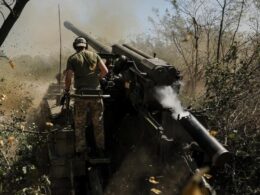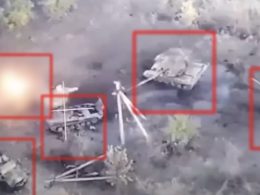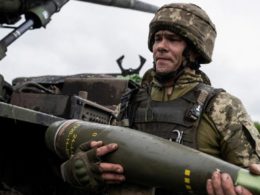Russia intensified attacks on the eastern front. Russian troops tried to advance near Kupiansk in the Kharkiv Oblast and the Bakhmut sector (Donetsk Oblast). The Ukrainian Army repelled Russian attacks south of occupied Bakhmut. However, the Russians managed to advance north of Bakhmut.
Russia continued its onslaught on Avdiivka in the Donetsk Oblast, attempting to encircle the Ukrainian stronghold. Ukraine’s Armed Forces effectively used kamikaze drones and cluster munitions to halt Russian infantry-led attacks in critical sectors of the Avdiivka defense.
As Russia stepped up its offensive on the eastern front to seize the strategic initiative, the Ukrainians continued to expand their bridgehead on the eastern bank of the Dnipro River in the Russian-occupied part of the Kherson Oblast (southern Ukraine).
Over the past week, Ukraine has carried out successful attacks on Russian warships in occupied Crimea. Apart from strikes at the Russian Black Sea Fleet, Ukrainians attacked military facilities behind Russia’s lines in the occupied territories of Ukraine and deep inside Russia.
Russian pressure on the eastern front
After more than a month of the Avdiivka offensive, heavy casualties, and minimal territorial gains, Russia had to regroup its forces for a new round of massive onslaught on the Ukrainian stronghold. The Russian army continued infantry-led attacks (so-called “meat assaults”) on the northern and southern flanks of Avdiivka.
Unlike the first weeks of the offensive in the Avdiivka sector, the Russians have stopped using tanks and armored vehicles en masse to break through Ukrainian defenses, which indirectly confirms the huge Russian losses.
https://twitter.com/EuromaidanPress/status/1723538386680434864
According to an OSINT analyst Naalsio, who documents Ukrainian and Russian military equipment losses based on photo and videographic evidence, from 9 October to 10 November, Russia lost 221 units of military equipment in the Avdiivka sector.
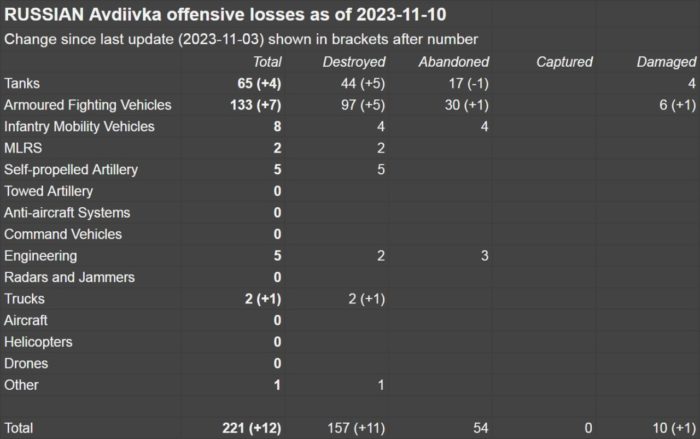
Credit: NAALSIO.
Ukraine lost 16 units of equipment while defending Avdiivka.
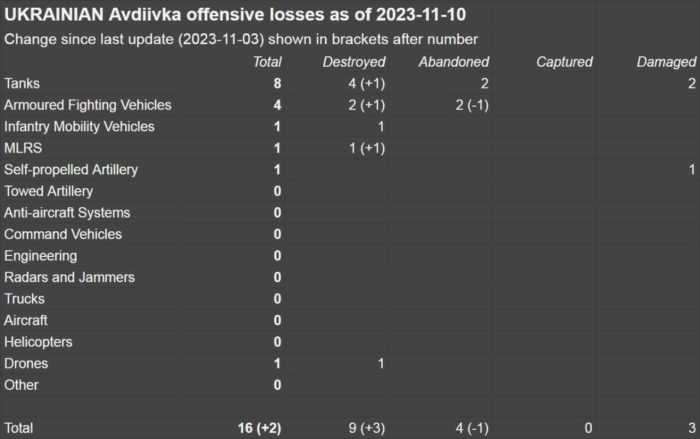
Credit: NAALSIO.
During a month of the Russian onslaught on Avdiivka in the Donetsk Oblast (eastern Ukraine), Russia lost around 10,000 troops, the Commander-in-Chief Valerii Zaluzhnyi of the Ukrainian Armed Forces reported.
According to Valerii Zaluzhnyi, since 10 October, Russia lost over 100 tanks, 250 other armored vehicles, about 50 artillery systems, and 7 Su-25 aircraft during the battle of Avdiivka.
Despite heavy losses, Russia still has reserves to continue the Avdiivka offensive. A Russian instructor with a call sign Philologist reportedly serving in the Donetsk Oblast (eastern Ukraine) named the effective use of cluster munitions and FPV kamikaze drones by the Ukrainian Armed Forces among the main problems Russian troops have to face during the Avdiivka offensive operation.
“I would single out three elements that have radically complicated the situation: HIMARS, kamikaze drones, and cluster munitions. It is the cluster shells that are now knocking out a huge mass of our infantry with a whole host of negative factors layered on. The infantry is suffering heavy excessive casualties on the battlefield, resulting in the disruption of combat missions, and in addition to this there is an overstretching of evacuation logistics and overloading of the military medical infrastructure,” the Philologist wrote on Telegram.
According to the Philologist, cluster munitions are a game changer that prevents Russian troops from breaking through Ukraine's defenses along the entire front line of more than 1,200 kilometers. He noted that the Ukrainians are skillfully using a combination of FPV kamikaze drones and cluster munitions to halt the Russian advance near Avdiivka and in other sectors of the front, from the Kharkiv Oblast in the north to the Kherson Oblast in the south.
https://twitter.com/EuromaidanPress/status/1723853214020260030
Cluster munitions drive Russian troops into deep hiding places, which restricts their ability to deal with Ukrainian counterattacks. As soon as reconnaissance drones detect Russian infantrymen sheltering from cluster munitions among the rubble in urban areas, Ukrainian artillery begins striking Russian hideouts, pushing enemy troops out of them into the open. When the Russian troops emerge from their hiding places, the Ukrainians fire cluster munitions at them.
When Russian infantry tries to move around the battlefield in armored vehicles, which protect soldiers from cluster munitions, Ukrainian kamikaze drones instantly target such vehicles.
“The armor itself is an easy target for small high-precision weapons, such as anti-tank guided missiles and kamikaze drones. If a successful hit turns the vehicle into a blazing iron flower, the paratroopers die,” the Philologist wrote on Telegram.
Thus, cluster munitions allow Ukrainians to knock out unprotected Russian infantry at a relatively low consumption of ammunition due to the high density of coverage of large areas with a huge mass of destructive elements coming at convenient angles.
However, despite heavy losses, the infantry-led assaults allowed Russia to approach Stepove, a small town north of Avdiivka. Last week, Russian troops entered the eastern outskirts of Stepove but were forced to retreat.
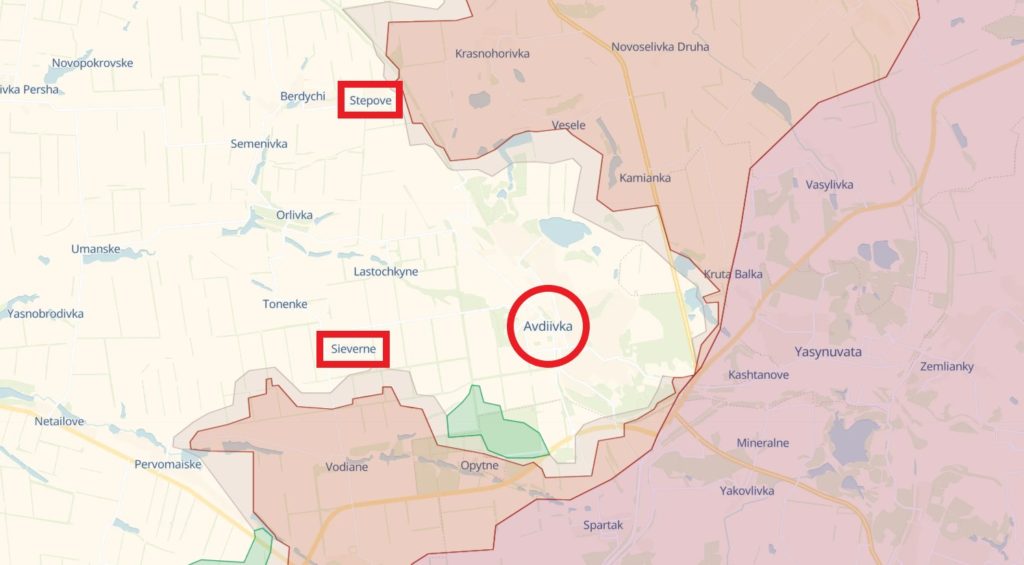
Map by Deep State.
Control of Stepove would allow the Russian army to come closer to the H0542 highway and disrupt the logistics of the Avdiivka garrison by pounding this critical supply route with mortar fire. Without cutting off the H0542 highway and occupying the Avdiivka Coke and Chemical Plant (a heavily fortified area held by Ukrainian defenders northeast of Avdiivka), the stability of Avdiivka's defenses is unlikely to be compromised. The Avdiivka Coke and Chemical Plant remains under complete Ukrainian control despite incessant Russian attacks.
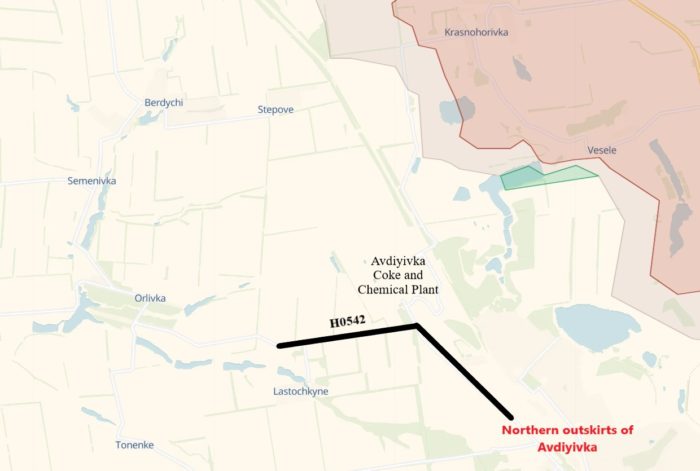
Map by Deep State.
Russia also intensified attacks on the southern flank of the Avdiivka sector, trying to occupy Sievierne in order to approach the H0542 highway from another side. Ukrainian defenders keep holding the line.
Besides assaults on Avdiivka, Russian forces counterattacked in the Bakhmut sector of the eastern front to recapture lost positions near Klishchiivka (south of occupied Bakhmut) and push Ukrainian troops out of their positions north of Bakhmut. Last week, the Russian army made confirmed advances near Yahidne on the northern flank of Bakhmut.
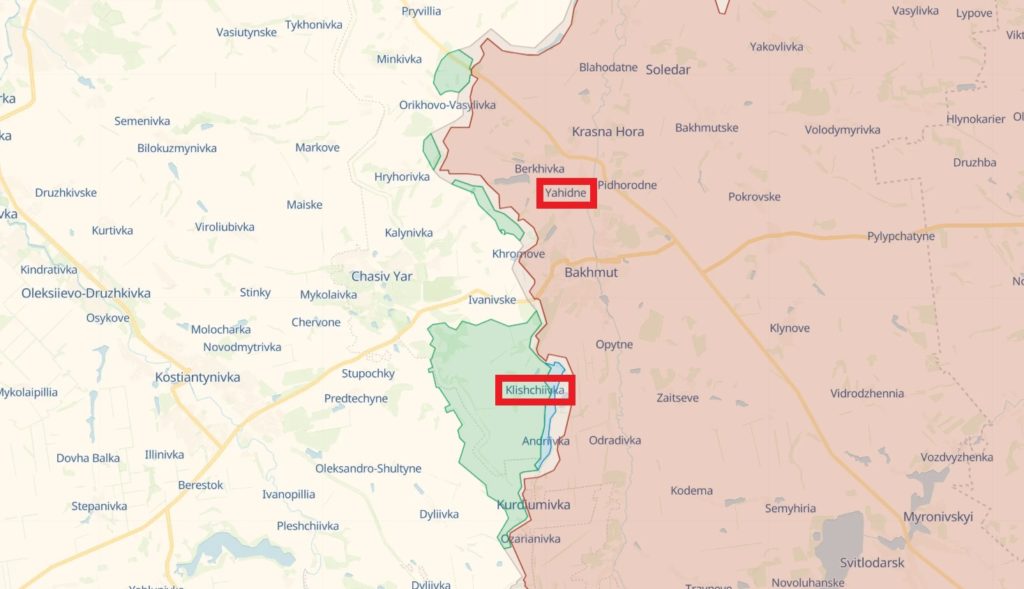
Map by Deep State.
Apart from counterattacks around Bakhmut, Russian forces continued assaults near Kupiansk in the Kharkiv Oblast, with no success. According to the Ukrainian military analyst Oleksandr Kovalenko, the Russian army cannot approach Kupiansk because Ukrainian troops have firm control of strategically important heights.
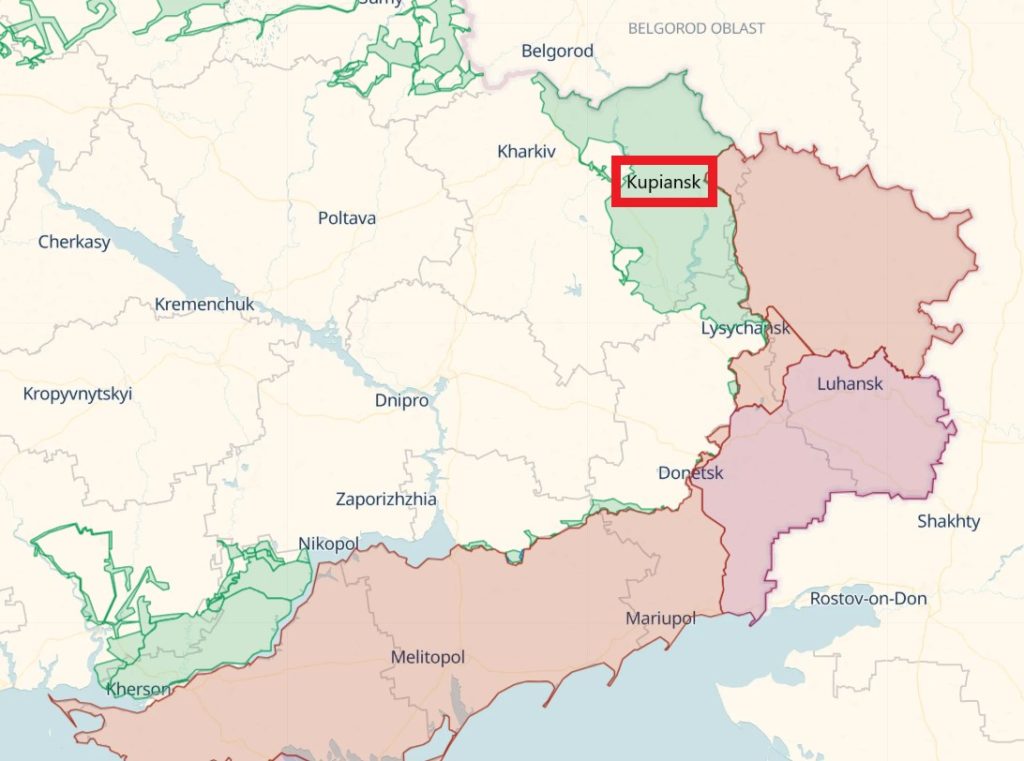
Map by Deep State.
Moreover, Russian forces are separated from Ukrainian positions in the vicinities of Kupiansk by a natural obstacle, the Oskil River. Ukrainians make the most of the landscape to organize defense in the Kupiansk sector.
Kupiansk is a crucial logistical hub and railroad junction occupied by Russia during the initial stages of the full-scale invasion. Ukraine liberated Kupiansk last fall during a successful counteroffensive in the Kharkiv Oblast.
Ukrainian offensive on the southern front
Last week, Ukraine’s Armed Forces consolidated positions in and around Krynky on the eastern bank of the Dnipro River in the Russian-occupied part of the Kherson Oblast. Ukrainian troops advanced to the forest south of Krynky. The Russian military command is pulling up reserves in this area to halt the Ukrainian advance further south.
It is 84 kilometers of flat fields from Krynky to occupied Crimea, with no rivers or hills that the Russian army can use as natural obstacles.
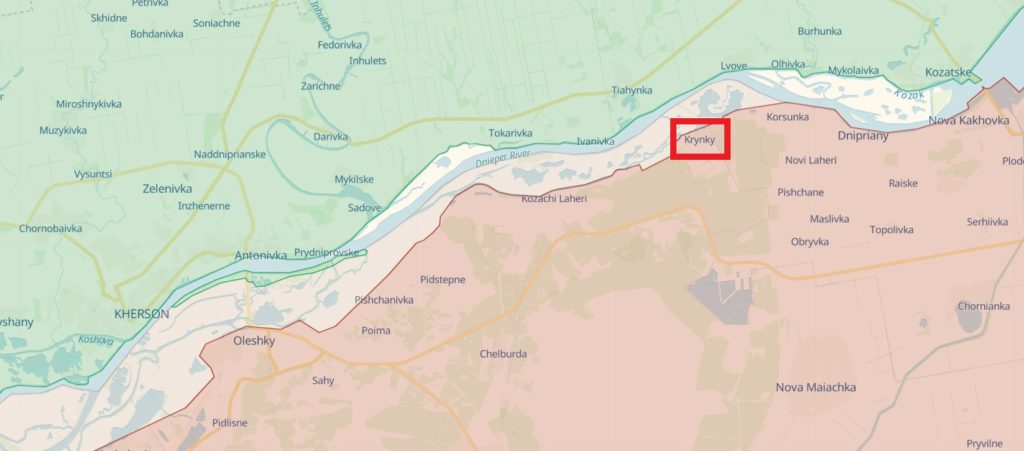
Map by Deep State.
There is a barren sandy terrain (the Oleshky desert) south of the forest near Krynky, where the heavy fighting is ongoing. If Ukraine manages to get armored vehicles and tanks across the Dnipro River, mechanized brigades will be able to enter an operational space where there are no settlements that the Russian army can turn into strongholds. Russia has no well-fortified defense lines and vast minefields in this area.
Russian military bloggers have already reported that a Ukrainian BTR-4E infantry fighting vehicle has crossed the Dnipro River to join the foothold established by Ukrainian troops in Krynky. It was the first sighting of Ukrainian heavy vehicles on the Russian-controlled bank of the Dnipro River in the Kherson Oblast since the beginning of the full-scale invasion of Ukraine. It is currently unclear how many armored vehicles the Ukrainian Armed Forces have already managed to transport across the Dnipro River.
Russian air superiority and relentless artillery fire hamper the transfer of armored vehicles across the Dnipro River. The Ukrainians need to significantly expand the bridgehead on the river's eastern bank to be able to move armored vehicles and tanks across the river en masse.
Russian attempts to force Ukrainians out of the forest south of Krynky yielded no success. Ukraine’s artillery stationed on the western bank of the Dnipro River suppresses Russian artillery fire and prevents Russian troops from approaching Krynky. Effective electronic warfare of Ukraine's Armed Forces, as well as precision artillery strikes at Russian electronic warfare systems, helped Ukrainians to isolate the battlefield around Krynky, limiting the Russian ability to conduct reconnaissance and use recon drones in this area.
https://twitter.com/EuromaidanPress/status/1723883434966229453
At the same time, Ukrainian kamikaze drones attack Russian troops, armored vehicles, and military trucks more than 20 kilometers deep into the Russian-controlled territories on the eastern bank of the Dnipro River and disrupt Russian logistics. Ukraine has already cut off a critical supply route of the Russian army from occupied Nova Kakhovka to the Kinburn Spit. Russia is forced to use other routes with a longer detour to supply its troops on the Kinburn Spit.
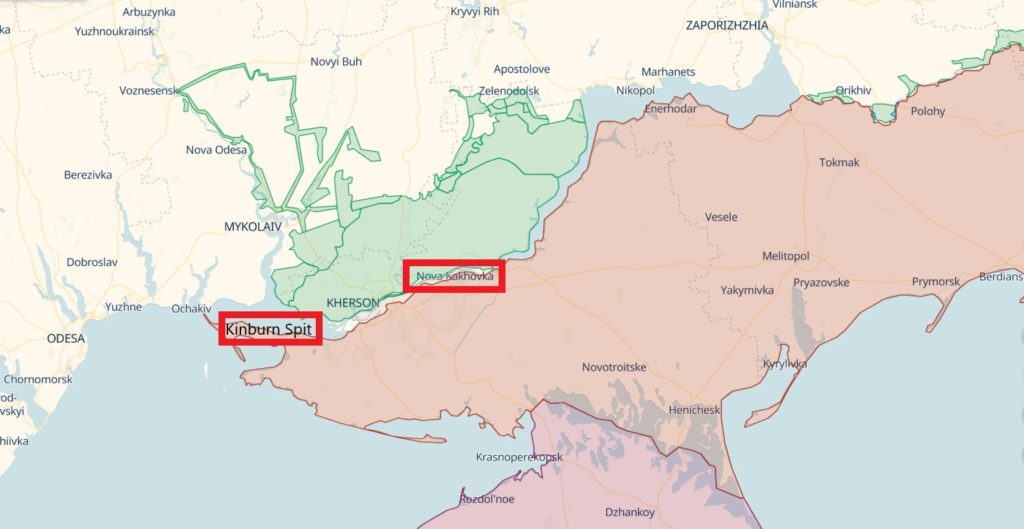
Map by Deep State.
The Russian army uses the Kinburn Spit to shell Ukrainian positions in the Kherson and Mykolayiv oblasts. Logistical problems undermine the stability of the Russian grouping on this isolated peninsula.
Strikes behind enemy lines
On 5 November, Ukraine’s Armed Forces struck
an ammunition depot and repair base in occupied Siedove in the Donetsk Oblast (eastern Ukraine).
According to Ukrainian journalist Andriy Tsapliyenko, several Russian helicopters that had landed in Siedove for repairs were damaged, along with the repair base. Official Russian sources did not confirm this information.
Siedove is located on the shores of the Sea of Azov, 7 kilometers from the occupied Novoazovsk (near the Russian border) and around 130 kilometers from the frontlines. The strike at the Russian military facility in Siedovo once again demonstrated the progress Ukraine has made in long-range capabilities since the start of the full-scale Russian invasion. It is becoming increasingly difficult for Russian troops to find a safe place in the occupied territory of Ukraine.
On 7 November, HIMARS strikes rocked the downtown in occupied Donetsk (eastern Ukraine): a building where Russian drone operators were training was hit. A series of successful Ukrainian strikes on the Russian rear continued within a few days.
On 9 November, a command post of the Russian army in occupied Skadovsk (Kherson Oblast, southern Ukraine) was hit. Ukraine allegedly used HIMARS to target the Russian base with high-ranking officers. Russian state news agency TASS reported five killed and ten wounded in the strike.
Overnight between November 9 and 10, Ukrainian forces conducted a successful operation, striking amphibious assault ships of Russia’s Black Sea Fleet in occupied Crimea, according to the Main Directorate of Intelligence (HUR) of Ukraine’s Defense Ministry.
According to HUR, Ukrainian maritime kamikaze drones struck two small Serna-class landing craft, namely an Akula (Shark) landing ship of the older project 1176 and a newer Serna-class warship of the project 11770. As a result of the attack, both Russian vessels sank
. The HUR reported that the Akula went down immediately, while the Serna fought unsuccessfully for survival but sank.
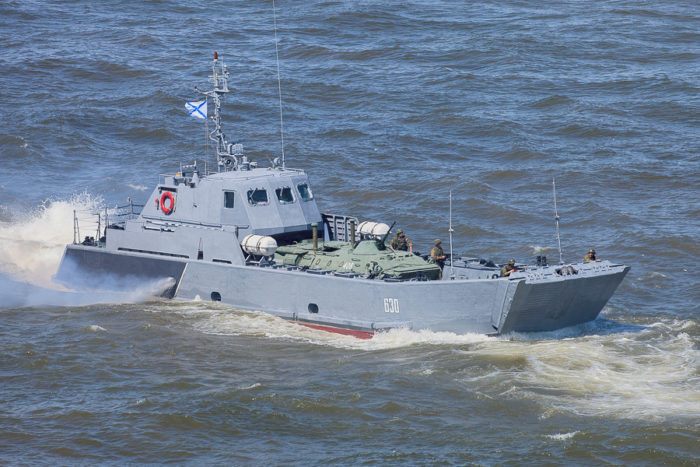
Illustrative photo via Wikipedia.
Russia heavily used these types of landing craft during its occupation of Zmiinyi (Snake) Island earlier in the war to transport military vehicles and personnel. Moreover, Russia also placed Tor-M2 anti-aircraft systems on the ships to provide air defense for its forces.
The Serna-class landing craft are highly mobile and can carry up to 45 tons of cargo and 92 armed personnel. Russia uses these vessels for rapid deployment of naval infantry and evacuation operations. With Russia’s naval air defenses diminished after Ukrainian strikes, these landing craft with anti-aircraft capabilities likely helped protect Russia’s Black Sea Fleet.
Since the beginning of the full-scale Russian invasion of Ukraine in February 2022, Ukraine’s Armed Forces have destroyed seven and damaged 16 warships of Russia’s Black Sea Fleet. Ukrainian missile strikes and maritime kamikaze drone attacks forced Russia to relocate some of its Black Sea Fleet vessels.
Over the past year, the Russian navy has been forced to relocate a significant portion of its missile carriers from occupied Crimea to the northeastern part of the Black Sea, more than 570 kilometers away from Odesa (southwestern Ukraine) and other top-priority targets west of the Crimean Peninsula.
Thus, Ukraine, a country with virtually no navy, forced powerful Russian warships to cling to the eastern part of the Black Sea shores. This unprecedented achievement will be written in golden letters in the history of warfare.
On 11 November, Ukrainian long-range kamikaze drones attacked the Kotovsk gunpowder plant in the city of Tambov, Russia (around 380 kilometers from the Russo-Ukrainian border). This factory is one of Russia’s largest producers of gunpowder for small arms and artillery ammunition, critical for Russian offensive operations against Ukraine.
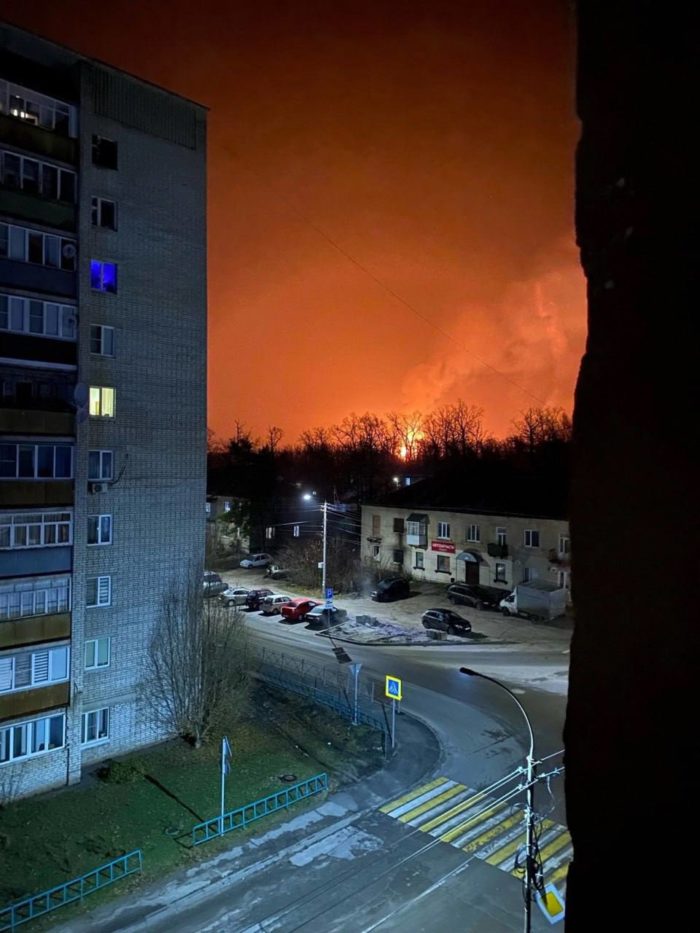
Credit: BAZA via Telegram.
During the full-scale Russian invasion of Ukraine, the Kotovsk gunpowder plant increased production of gunpowder and explosives by a third. In January-July 2022, the plant increased production by 34%.
This is the second Ukrainian strike on the plant since the all-out war with Russia began. The last time Ukraine struck the Kotovsk gunpowder plant was in June 2023.
Meanwhile, Russia resumed missile attacks on the Ukrainian capital after a long pause of 52 days. Russian military bloggers claimed that ballistic missiles struck an ammunition dump of Ukraine’s Armed Forces in the Kyiv Oblast and the airport in Boryspil (northern Ukraine). However, there is no confirmation of these claims.
Commander of Ukraine’s Air Force, Mykola Oleshchuk, reported that Ukrainian air defense shot down a Russian missile on its way to Kyiv, utilizing a Patriot surface-to-air missile launcher. According to Mykola Oleshchuk, the Russian army launched an attack on Kyiv using either an Iskander-M or an S-400 ballistic missile.
Although Russia has a critical advantage in long-range weapons, the effectiveness of Russian strikes on the Ukrainian rear suffers from a lack of intelligence. If Ukraine had as many long-range missiles as Russia, the war would have ended a long time ago. At least, that's what a popular Ukrainian joke about Russian long-range capabilities says.
Related:
- Weekly frontline update: Russia burns resources in Avdiivka, while Ukrainians expand bridgehead in Kherson Oblast
- Russian missile fired at Kyiv downed by Patriot system
- Ukraine hits Russian drone operator training facility in occupied Donetsk
- ISW: Ukraine increases attacks on Russian logistics and rear areas
- Ukrainian drone attack damages two Russian warships beyond repair
- Explosions and fire engulf Russian ammo depot in occupied Ukrainian village
- Ukraine’s army chief reports 10,000 Russian casualties in Avdiivka battle


